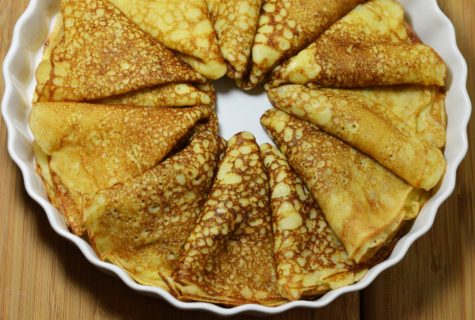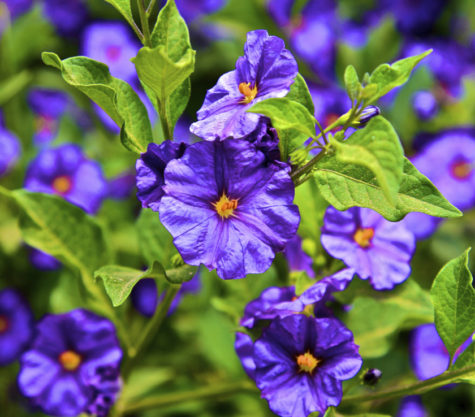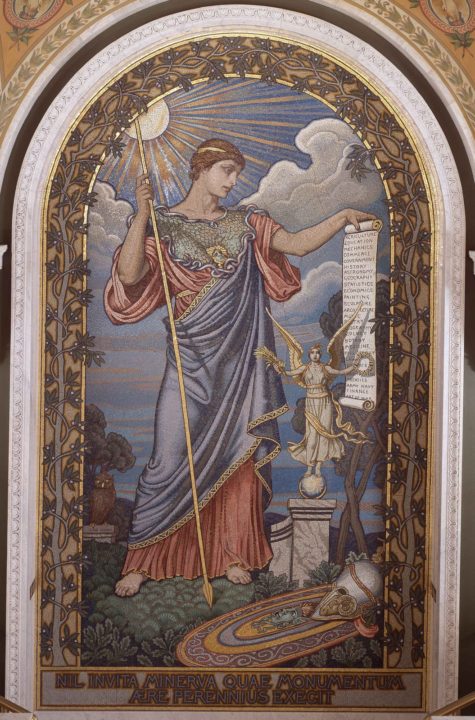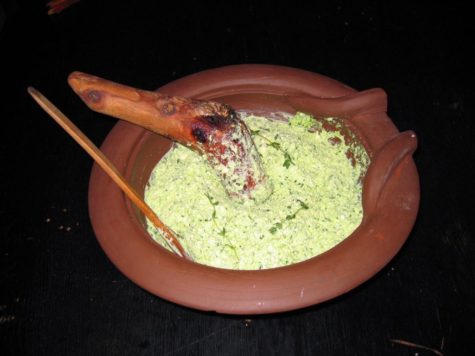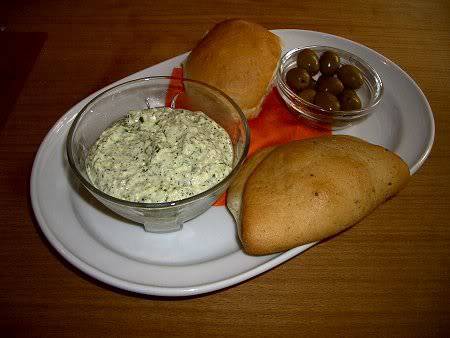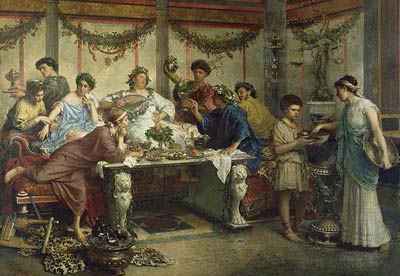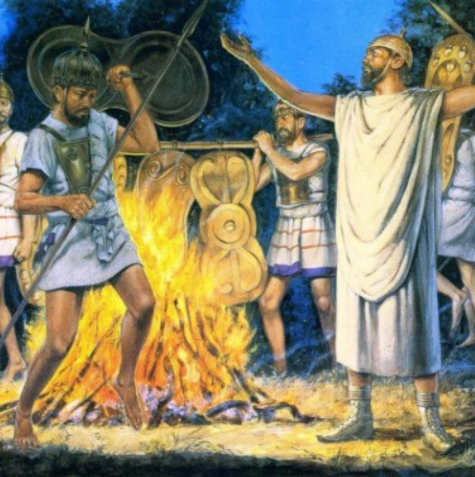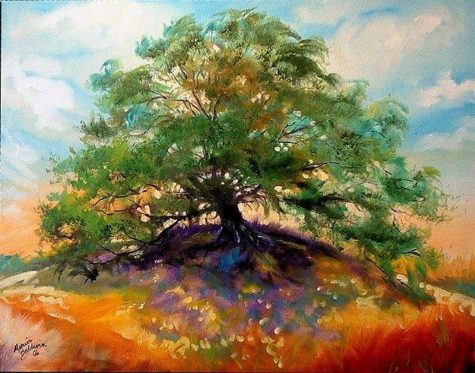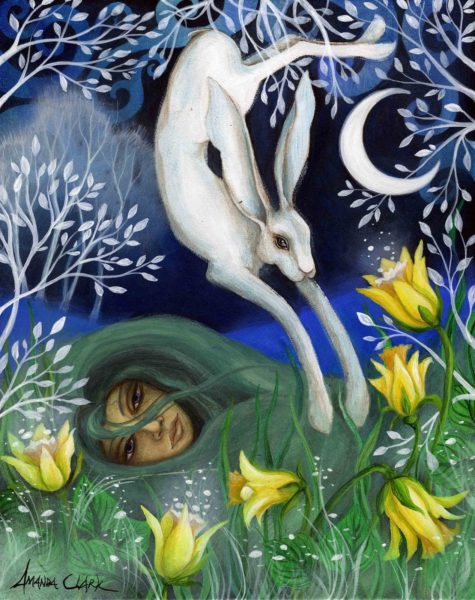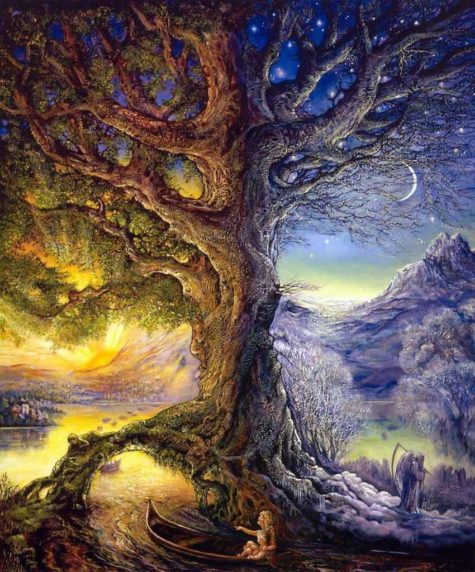shirleytwofeathers
Blins or blini were symbolically considered by early Slavic peoples in pre-Christian times as a symbol of the sun, due to their round form. They were traditionally prepared at the end of winter to honor the rebirth of the new sun. This tradition was adopted by the Orthodox church (Shrovetide, Butter Week, or Maslenitsa) and is carried on to the present day. Blini were also served at wakes to commemorate the recently deceased.
Traditional Russian blini are made with yeasted batter, which is left to rise and then diluted with cold or boiling water or milk. When diluted with boiling water, they are referred to as zavarniye blini. The blini are then baked in a traditional Russian oven. The process of cooking blini is still referred to as baking in Russian, even though these days they are almost universally pan-fried, like pancakes.
French crêpes made from unyeasted batter (usually made of flour, milk, and eggs) are also not uncommon in Russia, where they are called blinchiki and are considered to be an imported dish. All kinds of flour may be used for making blini: from wheat and buckwheat to oatmeal and millet, although wheat is currently the most popular.
What follows is a recipe for traditional Russian blini from RusCuisine. These pancakes are served with different dressings – most popular are sour cream, jam, syrup, red caviar, salmon, cottage cheese and others.
Ingredients:
- 3 1/2 c All-purpose flour
- 3 tb Water warm 105-F degrees
- 1 1/2 pk Yeast dry
- 3 3/4 c Milk warm 105-F degrees
- 1 tb Sugar
- 1/2 c Heavy cream
- 1 Egg white
- 2 Egg yolks
- 1 ts Salt
- 4 tb Butter unsalted melted and cooled until just warm
Take 1 tablespoon of the flour, the warm water, 1 teaspoon of the sugar, and the yeast and mix together in a small bowl. Cover and set in a warm place for 15 minutes. Mix in a large bowl the the 1 1/2 teaspoons of sugar, flour, milk, the yeast mixture and salt. Beat by hand for 4 minutes. Cover and set in a warm place for 1 hour.
Mix the egg yolks and remaining sugar and add to the natter along with the butter and beat with an electric mixer for 3 minutes or by hand for 8 minutes. Whip the egg white separately and whip the cream as well until very stiff. Fold in the cream then the egg white making sure to mix well. Cover again and place in a warm place for 45 minutes.
Grease the skillet with butter, place 2 tablespoons of batter in the center of the skillet, (at this point you may add any of the flavor garnishes that you wish or none at all) cook for 1 minute, turn the bliny over, and cook for 35 seconds, and serve smothered in sweet butter.
Dies Sanguinis (Day of Blood) was a festival held in Ancient Rome on 24 March. Also known as Bellona’s Day, this was an occasion when the Roman votaries of the war-goddess Bellona cut themselves and drank this sacrificial blood to propitiate the deity.
The worship of this asiatic goddess was introduced into Rome apparently by Sulla, to whom she had appeared, urging him to march to Rome and bathe in the blood of his enemies.
Note: She should not be mistaken for the Roman Bellona, whose festival, which was largely a huge feast, took place on the 3rd of June.
For her a new temple was built, and a college of priests (Bellonarii) instituted to conduct her fanatical rites, the prominent feature of which was to lacerate themselves and sprinkle the blood on the spectators. To make the scene more grim they wore black dresses (Tertullian, De Pallio) from head to foot.
The Priests of Bellona (also known as Bellonarii) practiced other rituals on Dies Sanguinis, one rite being to mutilate their own limbs, such as their own arms and legs with a sharp knife or knives in order to collect their own blood to either drink, or offer to their goddess Bellona in order to get her to invoke her war fury on them. In some instances, they would even drink their own blood in hopes that Bellona would grant a warlike frenzy.
An ancient source about Dies Sanguinis is in a book called “Apologeticum” by an early Roman Christian who states:
“on the sixteenth before the Kalends of April, that most sacred high priest of hers was offering, a week after, impure libations of blood drawn from his own arms…”
There also a plant known as the Bellonaria plant (solanum). Which is a corruption on the name Belladonna, a deadly nightshade, was used by priests at this festival, Dies Sanguinis.
When a priest ate its seeds, they would start to hallucinate. Those hallucinations were used by them to make prophetic and oracular statements in the name of their goddess.
Collected from various sources.
March 23 is the fifth day of the Quinquatria. A five day Roman festival to honor Minerva which coincides with the five day Ancient Greek festival to honor Athena – her Greek counterpart. Here is a ritual designed for group participation. It can, however, be modified for the solitary practitioner.
- Colors: Blue and brown
- Elements: Air and earth
- Altar: Upon a brown cloth light five blue candles, incense, and many tools of the crafter.
- Offerings: Make something.
- Daily Meal: Let those whose craft is cooking or baking make what they will as an offering.
Quinquatria Invocation III
Bones and clay of earth,
Flesh of trees and vines,
Thread from plant and animal,
Metal drawn from the ground
And forged in fire,
Our hands are midwives
To these unformed substances,
Given to us by the grace of the Mother,
As She gifts all her children.
We birth creations of beauty
That bring a smile to the eye,
We birth creations of usefulness
Made to be seized and worked day after day,
Fitting easily into the hand
That uses them unthinkingly.
Oh, ye many gods of the sacred touch,
Grant us the power to make manifest
With these our own humble hands.
(All approach the altar and select a tool, and speak their intentions towards it. Tools are then taken outside and laid on the Earth, and the Tool Blessing is said over them. Then, for the rest of the day, craftwork will be done, or things made or repaired.)
Tool Blessing (to be spoken or chanted or sung):
Father Labor, Mother Survival,
All brown gods of work and sweat;
Strong of arm, feet on Earth,
Bless this tool in Earth I set;
Sharp and keen, firm and fine,
Never break and never bend;
Be my strength, aid my skill,
Fill my hand and be my friend.
Found in: Pagan Book of Hours
Our recipe this week is straight out of the pages of Roman literature. Moretum is a delicious spread similar to our pesto—and the Roman poet Virgil was apparently a big fan!
The word “moretum” is Latin and is usually translated as “salad,” but that’s not really an accurate translation. It’s not a salad at all, at least not what we think of as salad in modern times. It’s a sort of spread or dip. Virgil is most often credited with the recipe. In his poem entitled “Moretum” he tells the story of Symilus, a peasant farmer, who is making his morning meal. He first makes the bread, but quickly realizes he has no meat to go along with the crusty creation. Concerned that man cannot survive on bread alone, he decides to make an accompaniment for his baked good. Virgil then describes the process by which Symilus makes his moretum. Both the bread and moretum-making are described in detail in the poem, but here is a little summary of the important moretum highlights, courtesy of Pass the Garum blog:
- Symilus gathers four heads of garlic (!), celery, parsley, rue, and coriander seeds.
- He grinds the garlic in his mortar and pestle, and adds salt and cheese.
- He then adds the celery, rue, parsley, and coriander seeds. The smell is so strong that it makes his eyes water!
- He adds some olive oil, finishes off the mixture, and slaps some on his freshly baked bread.
There are a couple of things about this recipe we will not be replicating in the recipe below. For one thing, there is an awful lot of garlic. We’re going to tone that down a bit, but feel free to pile it on if you’re a garlic fan. The Romans loved garlic. They believed it increased “strength and endurance” and so it was fed to “soldiers and sailors.”
It was also believed to “clean the arteries” and guard against toxins and infections. Today we know that garlic is often effective in treating and preventing many different ailments including, but not limited to, blood and heart conditions, some types of cancer, diabetes and even the common cold and flu.
More important than the potential overuse of garlic, rue is poisonous. However, rue is not altogether bad. In fact, it contains alkaloids that made it a useful treatment for indigestion during this time period (1st century BCE). But it also strongly influences the female menstrual cycle so pregnant women should definitely not consume it. We chose a recipe that leaves it out altogether.
Now that we’ve explored some history and cut out the dangerous ingredients, it’s time for a pesto party! Bake (or buy) a loaf of delicious bread to eat with your moretum and have some friends over for a night of Roman cuisine.
Roman Garlic Pesto (Moretum)
Ingredients
- 1 clove of garlic
- 1/2 of a celery stick (with its leaves)
- A small bunch of flat-leaf parsley
- 1 tablespoon of coriander seeds
- A pinch of salt
- Some aged pecorino cheese (approx. 8 ounces), feta is also a popular option
- 1 teaspoon of extra virgin olive oil
- A splash of vinegar
Instructions
Peel the garlic, add to the mortar and grind.
Add the salt, the cheese and the celery to the mortar and mash them up too. Really make sure to mix them well with the garlic from earlier.
To this paste, add the coriander seeds, parsley, oil and vinegar. I find that it is helpful to add the parsley in batches and break it down bit by bit rather than trying to do it all at once and making a mess. Test for flavor – if it is too garlicky, add more parsley.
Grab some bread and dip or spread ‘til your heart’s content!
From: Antiquity Now
In Ancient Roman religious tradition, The Hilaria (Greek: ἱλάρια; Latin: hilaris, “hilarious”) were festivals celebrated on the vernal equinox to honor Cybele, the mother of the Gods. The Romans took this feast originally from the Greeks, who called it ΑΝΑΒΑΣΙΣ, (Ascensus)
The day of its celebration was the first after the vernal equinox, or the first day of the year which was longer than the night (usually March 22) . The winter with its gloom had died, and the first day of a better season was spent in rejoicings.
The manner of its celebration during the time of the republic is unknown, except that Valerius Maximus mentions games in honor of the mother of the gods. Respecting its celebration at the time of the empire, we learn from Herodian that, among other things, there was a solemn procession, in which the statue of the goddess was carried, and before this statue were carried the most costly specimens of plate and works of art belonging either to wealthy Romans or to the emperors themselves.
All kinds of games and amusements were allowed on this day; masquerades were the most prominent among them, and everyone might, in his disguise, imitate whomsoever he liked, and even magistrates.
Here is a nice ritual to honor Cybele on her day from the Pagan Book of Hours:
- Color: Golden
- Element: Fire
- Altar: Upon a golden cloth set five gold candles, a chalice of wine, the figure of a lioness, and a crown resembling a turreted city.
- Offerings: Lions, herbs, wild game, music.
- Daily Meal: Game birds, such as turkey, goose, pheasant, or quail. Moretum – here’s recipe: Ancient Roman Garlic Pesto.
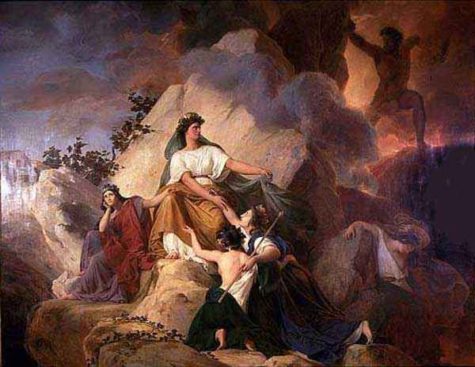
Invocation to Cybele
Magna Mater
Great Lady of the City
Protector of Civilization
Inspirer of music in the city streets
And in the high houses,
Queen upon your throne,
Guard the lands of stone and metal
Where the feet of thousands tread.
Magna Mater
Great Lady of the Wilderness
Protector of the Wild Things
Inspirer of music in lonely places
And in the deep metro’ons,
Lioness who hunts your prey,
Guard the beleaguered lands of untouched Nature
Where few feet tread
Save for the children of Earth whose steps belong there.
Magna Mater,
You who understand both worlds,
Do not let us forget
That both are valued in your eyes
That both hold promise and treasure
And that we must learn to live in both
If we are to survive.
(Beat drum and clash cymbals during chanting.)
Chant:
Magna Mater Cybele Cybele
Source: Wikipedia
In the Roman calendar, March was sacred to Mars. The “jumping priests,” or Salii began the Festival of the Salii on March 21 with a purification of the sacred trumpets that the Romans carried off to war. That date was originally the Roman New Year’s Day because it was the start of the growing and campaign season.
On March 21, the Salii marched to the Regia taking the bronze Ancilia, the sacred shield that had fallen down from heaven, and its 11 copies. They danced through the streets carrying poles with the shields mounted on them in their left hands. With their other hand, they banged the shields with a drumstick. Even in the time of Cicero, the Carmen Saliare they sang was so ancient that he could not understand it.
At the end of each night, they would stop at a place to be feasted before starting up again the next day. This festival would end on March 24 when they would return to the Regia and return the shields.
Found at Wikipedia
Birth date:
- Mar 21
Key word: Brave
According to some astrological traditions, it is said that if you were born on March 21st, you were born under the sign of the Oak tree. Persons born under this sign tend to have a robust nature. They are courageous, strong, unrelenting, independent, sensible, do not like change, keep their feet on the ground, a person of action.
Source: Wicca Chat
Artist: Marcia Baldwin
March 21 is the third day of the Quinquatria. A five day Roman festival to honor Minerva which coincides with the five day Ancient Greek festival to honor Athena – her Greek counterpart. Here is a ritual designed for group participation. It can, however, be modified for the solitary practitioner.
- Color: Blue
- Element: Air
- Altar: Upon a blue cloth lay many musical instruments, blue candles, a clear glass bowl of water, and a fan made from a bird’s wing.
- Offerings: Song and music.
- Daily Meal: Light vegetarian meal.
Quinquatria Invocation II
(to be sung)
Hail Athena, true and bright,
Sharp your blade and keen your sight,
Goddess of a Thousand Works,
Giver of the soul in flight.
Guide our touch as we reach out,
Weaver, crafter, artisan,
Guide our urge to build and make,
Guide the power of our hands.
Mentor, teacher, patient tutor,
Maker of heroes through the years
In the epic glance of history,
Giving sight to blinded seers,
Giving purpose to the wanderer,
Giving courage to the weak,
We beseech you, armored Lady,
By the Word of Power you speak,
Like the wind that blows so cold
And bright and clear through minds of grey,
Stand beside us when we falter,
Sweep our weakness clean away.
(The rest of the day should be spent in song, whatsoever has been chosen by the community as the absolute best that they can do, as an offering. Songs can be solo offerings, or as a group. Those who wish to give private offerings can play instrumental music after the main group has left.)
Found in: Pagan Book of Hours
Also known as: Oestre, Easter, the Spring Equinox, Vernal (Spring) Equinox, Alban Eiler (Caledonii), Méan Earraigh
- March 20 – 23 Northern Hemisphere
- September 20 – 23 Southern Hemisphere
This is the official return of the young Goddess after her Winter hibernation. As with the other Equinox and the Solstices, the date of this festival may move slightly from year to year, but many will choose to celebrate it on 21 March.
The Spring Equinox is the point of equilibrium – when light and darkness are in balance but the light is growing stronger. The balance is suspended just before spring bursts forth from winter. Night and day are of equal length at the equinox, the forces of male and female are also in balance. Ostara is a festival of balance and fertility.
In keeping with the balance of the Equinox, Oestara is a time when we seek balance within ourselves. It is a time for throwing out the old and taking on the new. We rid ourselves of those things which are no longer necessary – old habits, thoughts and feelings – and take on new ideas and thoughts. This does not mean that you use this festival as a time for berating yourself about your ‘bad’ points, but rather that you should seek to find a balance through which you can accept yourself for what you are.
It is also a celebration of birth and new life. A day when death has no power over the living.
Spring has arrived, and with it comes hope and warmth. Deep within the cold earth, seeds are beginning to sprout. In the damp fields, the livestock are preparing to give birth. In the forest, under a canopy of newly sprouted leaves, the animals of the wild ready their dens for the arrival of their young. Spring is here.
It is no coincidence that the name for this sabbat sounds similar to the word ‘Easter’. Eostre, or Ostara, is an Anglo-Saxon Dawn Goddess whose symbols are the egg and the hare. She, in turn, is the European version of the Goddess Ishtar or Astarte, whose worship dates back thousands of years and is certainly pre-Christian. Eostre also lives on in our medical language in the words ‘oestrous’ (the sexual impulse in female animals) and ‘oestrogen’ (a female hormone).
Today, Oestara is celebrated as a spring festival. Although the Goddess put on the robes of Maiden at Imbolg, here she is seen as truly embodying the spirit of spring. By this time we can see all around us the awakened land, the leaves on the trees, the flowers and the first shoots of corn.
There is some debate as to whether Oestara or Imbolg was the traditional time of spring cleaning, but certainly the casting out of the old would seem to be in sympathy with the spirit of this festival and the increased daylight at this time encourages a good clean out around the home.
The Easter Bunny also is of Pagan origin, as are baskets of flowers. Brightly colored eggs represent the child within.
Traditionally, Ostara is a time for collecting wildflowers, walking in nature’s beauty and cultivating herb gardens. Half fill a bowl with water and place a selection of flowers into it for display in a prominent position in your home.
This is the time to free yourself from anything in the past that is holding you back.
Sources: varied
And frosts are slain and flowers begotten,
And in green underworld and cover
blossom by blossom the spring begins.
~Algernon Charles Swinburne
Méan Earraigh marks the spring equinox, when night and day are of equal length and spring officially begins. Birds begin their nesting and egg-laying, and eggs–symbolic of rebirth, fertility, and immortality–are tossed into fresh furrows or eaten by ploughmen. They are also carried by those engaged in spring planting.
A charming custom is painting eggs with symbols and pictures of what one wishes to manifest in the coming year. The eggs can then be buried in the Earth Mother, who hears the cries and dreams of her children. In some communities, eggs are hidden in the stores of seed grain and left there all season to bless the sowing and encourage the seeds to sprout. Dressed as mummers, “pace-eggers” go from house to house and demand eggs and coins in return for a short performance. Men and women exchange clothing for the show.
The eggs given to the pace-eggers have been wrapped in leaves, roots, flowers, and bark before boiling, to impart color. Later the eggs are used in games, such as attempting to strike an opponent’s legs. The eggs might be hidden or rolled down hillsides, after which they are eaten. Blood, ashes from sacred fires, fistfuls of salt, or handfuls of soil from a high mountaintop are scattered on the newly sown fields.
Offerings of food and milk are left for the faeries and other spirits who live in and around rocks and are responsible for the fertility of the land. A few fruits from the previous year’s harvest are left for the nature spirits. Sacred hilltops are visited, and picnics of figs, fig cakes, cider and ale are enjoyed. The figs are symbolic of fertility, the leaf being the male element and the fruit the female.
You can also celebrate the arrival of spring with flowers. Bring them into your own home and give them to others. You do not have to spend a lot of money – one or two blooms given for no other reason than ‘spring is here’ can often bring a smile to even the most gloomy face.
A traditional Vernal Equinox pastime is to go to a field and randomly collect wildflowers (thank the flowers for their sacrifice before picking them). Or, buy some from a florist, taking one or two of those that appeal to you. Then bring them home and divine their Magickal meanings by the use of books, your own intuition, a pendulum, this post on the Magickal Meanings of Flowers, or by other means. The flowers you’ve chosen reveal your inner thoughts and emotions.
In the druidic tradition, Aengus Og is the male deity of the occasion. Son of In Dagda and Boand, he was conceived and born while Elcmar, Boand’s husband, was under enchantment. When three days old, Aengus was removed to be fostered by Midir, god of the Otherworld mound at Bri Leith, with his three hostile cranes. These birds guarded the mound and prevented the approach of travelers, and were said to cause even warriors to turn and flee.
Make an Altar to Ostara.
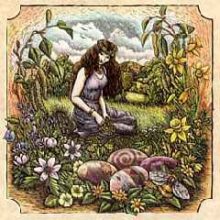 Ostara, the ancient German Virgin Goddess of Spring, loves bright colors. The light pastels of spring are perfect offerings for Ostara. To represent earth on your altar, choose bright or pastel colored stones like Rose Quartz, Amethyst, or any of the Calcites (blue, red, yellow, or green). If you have some Citrine, be sure to include it. Citrine has long been an aid for mental clarity.
Ostara, the ancient German Virgin Goddess of Spring, loves bright colors. The light pastels of spring are perfect offerings for Ostara. To represent earth on your altar, choose bright or pastel colored stones like Rose Quartz, Amethyst, or any of the Calcites (blue, red, yellow, or green). If you have some Citrine, be sure to include it. Citrine has long been an aid for mental clarity.
By including an offering of colored eggs on your altar, you will be taking part in an ancient tradition (still performed!) by the Germanic people. Ostara has been honored this time of year with painted eggs for centuries.
To symbolize fertility, in addition to the eggs, you can include seeds or rice on your altar. I like to use rice as a symbol for fertility on my altars.
Incense and feathers are perfect symbols for air on your altar. It is important for Ostara’s altar that you include a symbol for air because Ostara herself is the living symbol for Air. (This must be the way Ostara and Easter became associated with birds, i.e. chickens) Be sure to burn incense at your altar when you are dedicating it to bring in the energy and vibrational qualities of Ostara.
The perfect time to dedicate your altar is at dawn. Choose a day, then plan to dedicate your altar to Ostara at dawn’s first light by lighting incense and repeating an invocation to her as well as a prayer of thanksgiving for all that Ostara symbolizes in your life:
- A clear mind.
- New beginnings.
- Personal renewal.
- Fertility, either for the purpose of bearing a child or for creativity such as arts and crafts, writing, or decorating.
You can include anything you like on your altar to Ostara. You will know by how you feel if an item is appropriate or not. I believe it is important to include symbols for the four elements on my altars. The four elements are Fire, Earth, Air, and Water. The four Calcites on my altar (red/fire, green/earth, yellow/air, and blue/water) represent Mother Earth and the four elements. I have added feathers and other items that symbolize Ostara to my altar as offerings to her.
Last, but not least, it might be nice to include a figure of a rabbit. The rabbit is Ostara’s power animal. I am sure this is because of their propensity for fertility.
